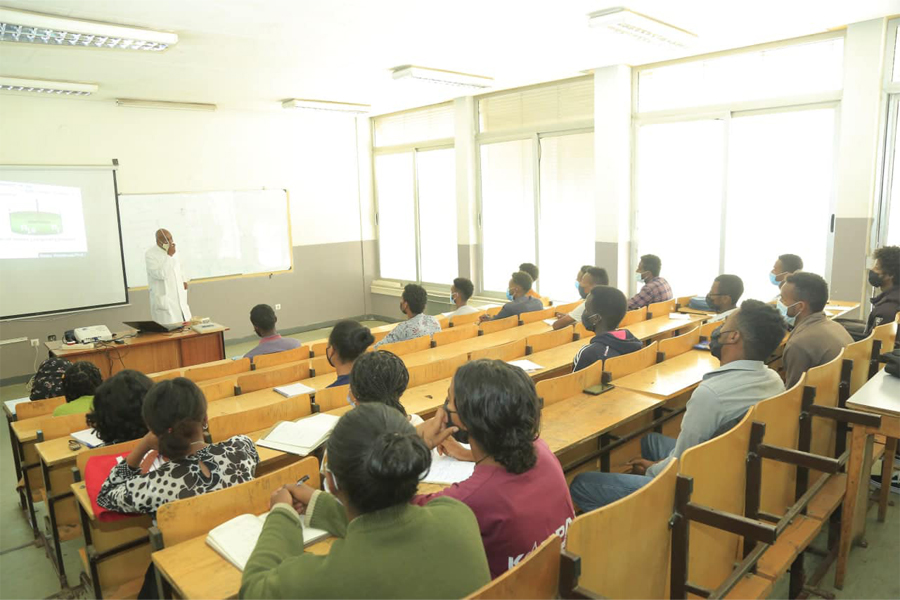
Agenda | Aug 25,2024
Sep 21 , 2019
By Alemayehu Geda (PhD)
The problem diagnosis used in the Homegrown Economic Reform Plan seems to be based more on the IMF’s templates than the reality on the ground, threatening to make it just a wish list instead of a solution argues Alemayehu Geda (PhD), professor of economics at Addis Abeba University and research associate at the University of London.
A closer examination of the “homegrown” economic policy reform shows that it does not look as homegrown as claimed, because it is strikingly similar to a typical IMF programme for reforming (read liberalising) developing countries and copied from such templates. It does not start with understanding the real economic problems at home. As a result, the review and diagnosis in the policy are based on such templates instead of the real issue on the ground.
For instance, the source of growth analysis is misleading, because it claims that the bulk of the source of growth had been capital accumulation (5.2pc out of the 10pc growth and efficiency follows at 2.6pc out of the 10pc growth). We know for a fact that the contribution of capital has been only 1.6pc, labour 2.4pc and technology/efficiency about 1pc. The government’s presentation shifted the statistical artefact embodied in the data called efficiency (TFP)/technology, which proper analysis of the official data would have shown to be 6.7pc, toward capital accumulation and efficiency/technology – the latter’s contribution even in advanced countries is about 2pc and in Ethiopia it is historically about 1pc and fluctuates with rainfall.
This wrong diagnosis led the government to a wrong area of focus in its policy. This is shown to be the majority in the list of efficiency-seeking policies envisaged in the document.
Also, the exaggerated GDP growth used will certainly give the wrong forecast of the government’s revenue collection ability and debt carrying capacity with implications for policy. I also think the level of saving is exaggerated and that of poverty understated. These and related facts on the ground and failure to take them on board in this policy document has a detrimental effect on envisaged targets, proposed policies and their realisation in the three years to come.
The fundamental sources of the macroeconomic problems of the country are missing. These problems are sectoral imbalances, which basically mean the planned growth was not related to the supply of food and the foreign exchange generating capacity of the economy, the dependence of growth financing on external debt and deficit financing or money printing, the inter-temporal mismatch between the medium-term planning (the GTAP) and annual budget and inter-Ministry long-term plans. The policy prescribes a solution without identifying these root causes of the problem.
The “structural and sectoral policies” of the reform and its conceptualisation and understanding of Ethiopian structural problems is significantly deficient. As a result, so are the policies proposed to address them. An economy has a structure if its institutions and the behaviour of economic agents entail a certain pattern of resource allocation that is different from others. Most African countries have such a unique structure which is also historically formed and hence economic performance is path-dependent. It is from such correct understanding of the economic structure the UN-ECA some three decades ago defined the structural problems of African countries in terms of deficiencies in basic economic and social infrastructure, research capability, technological know-how and human resource development, compounded by problems of socio-political organisation.
In such context, inflation, balance of payments deficits, a rising debt burden and the instability of exports, which were focused on in the World Bank/IMF’s view of the Africa problem in the 1980s, are taken by the ECA as resulting from a lack of structural transformation, as well as excessive dependence on the external sector. They noted such structural weaknesses in Africa’s productive base, the predominant subsistence/informal and exchange nature of the economy and its vulnerability to the external economy have all conspired to perpetuate the economic crisis. In my view, the Ethiopian economy today shows these structural features that need structural solutions. This understanding of structural problems is contrasted with the “homegrown” reform’s understanding of it.
Real Structural Problems in today’s Ethiopia are human capital deficiency; food sector deficiency; export-sector structural supply problems; structural import dependence problems; structural dependence on external finance; structural unemployment; the politics of inflation, distribution of income and poverty. Currently, general inflation sits at 18pc and food inflation is 23pc. These are structural problems that need policies to create a market, and a structural transformation needs state capacity.
In contrast, the following are the structural problems identified by the government's reform policy: streamlining bureaucratic and regulatory procedures; improving governance of public institutions, improving power reliability and access through modernizing corporate governance and improving operational efficiency at EEU and EEP; restoring cost recovery through tariff reforms; implementing the telecom sector reform; creating secure and predictable market access to exports, including by expediting WTO accession and strengthening regional trade integration; undertaking logistics reform to enhance logistics efficiency and invest in logistics infrastructure; improving the efficiency of domestic markets, such as by removing barriers to entry, enforcing the competition law, and improving the efficiency of the commodity market supply chain.
These are policies to perfect an existing market that does not have structural problems such as those I defined.
Even assuming that the government’s understanding of structural problems is right, which is a heroic assumption, there is an inevitable contradiction and mismatch between the macro policy and structural and sectoral policies envisaged to address the problems, as well as the instruments of policy to be used for the purpose. To address the Ethiopian structural problems, three dynamically interrelated aspects of proposed solutions need to be considered. First, the operative forces (political, economic, scientific and technological, environmental, cultural and sociological); second, the available resources (human and natural resources, domestic saving and external financial resources); and third, the needs to be catered for (focusing on vital goods and services as opposed to luxuries and semi-luxuries). Such a framework is missing.
At a concrete level, the structural policy directions require taking several policy directions. First, improving production capacity and productivity, the mobilisation and efficient use of resources, human resource development, strengthening the scientific and technological base, and vertical and horizontal diversification. Secondly, improving the level and distribution of income, adopting a pragmatic balance between the public and private sectors, putting in place enabling conditions for sustainable development, particularly economic incentives and political stability, the shifting of non- productive resources, and improving income distribution among various groups. Finally, focusing on the required needs, particularly food self-sufficiency, reducing import and external finance dependence, the re-alignment of consumption and domestic production patterns. Almost all such structural policy directions are missing in the proposed policy framework. Key among these deficiencies is the human capital and professional expert base deficiency that the policy missed. However, the latter is a fundamental condition to carry out, implement and monitor such policy.
Notwithstanding the above, the proposed macroeconomic and financial sector policies also have some good features. Unfortunately, they are not many. These include some of the policies for the foreign exchange market, public finance management, including debt management, and the import substitution policies proposed. However, it is imperative to re-examine them in the context of the weakness that I have pointed out above and attempt to address some of the conflicting policy outcomes that may arise from the use of short-run macroeconomic and financial policies and long to medium-term structural policies.
For instance, one can see a contradiction between policies related to mobilisation of saving and low-cost finance for investment; contractionary monetary policy and keeping the momentum of growth; the 10-billion-dollar resource requirement and debt sustainability and external finance dependency; liberalisation and increasing competitiveness of infant industries, as well as state capacity to do all these and poverty reduction and privatisation of key strategic assets. Given such fundamental weakness, what should be done next?
The starting point is to re-examine the policy in light of its weaknesses as outlined here and take remedial action.
As a way forward, plan on how to address the sectoral imbalances between the targeted growth and food sector growth and foreign exchange (FX) generating capacity. In the short term, an increase in agricultural output with a small investment can be achieved through small irrigation development, fertiliser and high yield seed supply, and agrarian reform in the medium to the long run. Detailed sector or item targeted FX saving and generating capacity in the short run and manufactured goods exports development in collaboration with China and other development partners in the medium term. These are also key issues to address the macroeconomic imbalance problem in general and the inflation problem in particular. This needs to be complemented by streamlining of the basic goods supply chain and supplying such goods at regulated prices to urban dwellers through direct government distribution schemes targeting the poor by controlling the huge degree of monopoly merchants and middlemen have.
This economic reform plan will be a wish list without able experts and technocrats at core ministries. So, set up project analysis and evaluation offices across main ministries and staff them with at least ten high-caliber economists, engineers and IT professionals, in particular at the Ministries of Industry, Agriculture & Finance in the short run. In the medium to long run, create public sector technocrat schemes that pay better than the private sector and have a social premium that attracts the brightest that want to serve their country. Set up a development projects analysis and monitoring department under the Planning Commission staffed with technocrats selected on merit to oversee all such departments at the ministries and improve its analytical capacity. Make a distinction between technocrats such as deputy ministers and political appointees such as minsters. The former being a professional picked on merit. Develop macro-econometric models with detailed monetary block in the Research Department of the NBE and with detailed fiscal block at the Planning Commission to be used for the budget process (learn from Kenya on both). These need to be complemented by long to medium-term perspective indicative planning and a growth model in the planning commission. A serious budget needs to be allocated to attract and maintain the best technocrats in a sustainable manner.
Avoid throwing all policy diagnosis and analysis to technical assistance that is coming from outside, staffed by people that do not have in-depth knowledge about the politics, economy and history of the country and are invariably informed by their county’s national interest. Use national socioeconomic research centres like the Ethiopian Economic Association and the economics departments of the country’s universities instead. The government needs to be in the driving seat to formulate and implement its policymaking for it to be genuinely homegrown. The technical assistance from groups such as the IMF, WB and Harvard from outside should be complementary and supportive – not the other way around as it is now.
Having put this in place, do a detailed diagnostic study in core ministries. In the long-run, this should be handled by a true technocrat Economic Council under the Prime Minister’s Office which would be recruited based on merit, not ideology, politics or the influence of international financial institutions. Hopefully, eventually, this will be made part of the constitution – S. Korea and the US are good examples of this.
Finally, plan on a sustainable financing strategy that includes how to transit from aid and external finance dependency in the coming five to ten years. This includes domestic resource mobilisation, leveraging remittance, focusing on foreign exchange generation through structural transformation by leveraging the existing engagement with and assistance from current partners both in the West and East, in particular China, India and South Africa.
PUBLISHED ON
Sep 21,2019 [ VOL
20 , NO
1012]


Agenda | Aug 25,2024

Fortune News | Jun 27,2020

Commentaries | Dec 04,2020

Radar | Oct 28,2023

Viewpoints | Oct 31,2020

Fortune News | Apr 10,2023

Viewpoints | Dec 19,2020

Editorial | May 06,2023

Fortune News | Nov 02,2025

Viewpoints | Jun 21,2025

Photo Gallery | 179933 Views | May 06,2019

Photo Gallery | 170130 Views | Apr 26,2019

Photo Gallery | 161121 Views | Oct 06,2021

My Opinion | 137233 Views | Aug 14,2021

Dec 22 , 2024 . By TIZITA SHEWAFERAW
Charged with transforming colossal state-owned enterprises into modern and competitiv...

Aug 18 , 2024 . By AKSAH ITALO
Although predictable Yonas Zerihun's job in the ride-hailing service is not immune to...

Jul 28 , 2024 . By TIZITA SHEWAFERAW
Unhabitual, perhaps too many, Samuel Gebreyohannes, 38, used to occasionally enjoy a couple of beers at breakfast. However, he recently swit...

Jul 13 , 2024 . By AKSAH ITALO
Investors who rely on tractors, trucks, and field vehicles for commuting, transporting commodities, and f...

Nov 1 , 2025
The National Bank of Ethiopia (NBE) issued a statement two weeks ago that appeared to...

Oct 25 , 2025
The regulatory machinery is on overdrive. In only two years, no fewer than 35 new pro...

Oct 18 , 2025
The political establishment, notably the ruling party and its top brass, has become p...

Oct 11 , 2025
Ladislas Farago, a roving Associated Press (AP) correspondent, arrived in Ethiopia in...

Nov 2 , 2025
The National Bank of Ethiopia (NBE) has scrapped the credit-growth ceiling that had s...

Nov 2 , 2025 . By SURAFEL MULUGETA
The burgeoning data mining industry is struggling with mounting concerns following th...

Nov 2 , 2025 . By YITBAREK GETACHEW
Berhan Bank has chosen a different route in its pursuit of a new headquarters, opting for a transitional building instea...

Nov 2 , 2025 . By BEZAWIT HULUAGER
Nib International Bank S.C. has found itself at the epicentre of a severe governance...